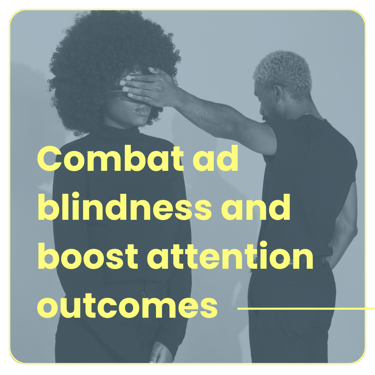Our technology measures how much screen space your ad occupies. The more space, the more attention it demands. Thus, large high impact formats are ideal for capturing attention.
It's all about attention
Unlock the power of attention for unmatched ad performance
Attention is the gold standard in media measurement, surpassing traditional metrics like viewability. Stay ahead of the curve with attention-focused strategies that drive superior ad performance and ROI. Use Adnami to capture more attention and achieve meaningful business results.
The evidence speaks for itself - attention outperforms CTRs, viewability and other metrics in predicting key outcomes.
You don't just want your ad to technically be able to be seen, as viewability indicates - you want it to be seen. This is where attention comes into play. As a proven driver of brand success, attention is a clear indication of positive business results.
Optimising your ads for attention increases engagement, brand awareness, brand recall, consumer trust, purchase intent and ultimately sales. But don’t just believe us, listen to the massive research conducted by the IAB, Dentsu, or the Attention Council. As Forbes summarises, “Simply put, more attention means more sales”.
Increase your return on investment by effortlessly integrating attention into your media planning and campaigns with Adnami.
Use the right formats
Use high impact formats to tell stories with video, emotion and rich media.
Activate seamlessly
Activate based on attention-optimised strategies or use our curation services.
Measure what matters
Use Sonar to analyse which ads, formats & domains etc. capture the most attention.
Optimise on the fly
Use our data and tools to optimise campaigns to where attention is highest.
Feeling nerdy?
Want to learn more about how to capture the most attention? Download our white paper to get actionable tips for every step of your ad journey.
Which of the two ads captures your attention? If it's the one on the bottom screen, we've got you covered. Adnami specialises in high impact display formats and designs that are sure to capture your audience's attention.


Sonar is part of Adnami’s offering that lets you measure attention across creatives and campaigns. Understand which creatives capture the most attention. Identify the most attention-grabbing content and strategically place ads where consumer attention is highest. Sonar enables advertisers like you to obtain meaningful insights and take action.
As the industry shifts towards aiming for attention rather than viewable impressions, there’s a need for metrics that can be applied to both high impact and standard display formats. Attention per mille (APM), effective attention per mille (eAPM) and attentive cost per mille (aCPM), have proven to be actionable metrics for driving the best business results.
[APM]
Attention per Mille (APM) indicates the attention generated per 1,000 visible impressions.
Measure your creative’s performance and compare different versions.
[eAPM]
Effective Attention per Mille (eAPM) indicates the attention generated per 1,000 served impressions.
Analyse the attention performance of your media buying activities.
How do we measure attention?
Our attention metrics, APM and eAPM, are driven by data from several key attention signals.
-
-
Visibility is an expression of how much of an ad is in view. It's measured from the first millisecond as studies have shown that attention can already be generated from the first millisecond.
-
Time-in-View is essential to attention. The longer an ad is in view the more likely the message is to resonate with consumers. Typically, it is the first ten seconds that generate the most attention.
-
Placing your ad on the right spot on a website page is crucial for driving attention. Ideally, it should be placed within the content zone at the centre and as high up the page as possible.
-
Adnami measures clicks, swipes or scrolls, to determine engagement. We only include a maximum of one engagement per consumer to not distort data and results.
The word "advertising" is derived from the Latin word 'advertere' which means 'to turn the attention'. We take that by the word (pun intended), going back to the roots and the future of advertisement at the same time. Let's talk and explore how Adnami puts attention at the centre of your ads.

The increasing amount of online advertising has led to a phenomenon known as “ad blindness” where users pay less attention and ignore most ads. For your brand to stand out you need to capture attention. At Adnami, we specialise in boosting attention outcomes and combatting ad blindness with attention-proof formats and smart attention measurement.
Publishers thrive on attention
Publishers can struggle to build and maintain readership. With consumers’ increased privacy awareness, sites benefit from hosting relevant, trustworthy ads. Ads optimised for attention are high-quality, high-relevancy ads that resonate with readers and consumers, whilst respecting their privacy. Explore how Adnami empowers publishers.
Advertisers cut through the noise
As an advertiser fighting with ad and content overload, it can be a struggle to cut through the noise. Optimising for viewability isn't enough. You don't just want your audience to be technically ABLE to see your ad, you want your ad to be SEEN. With Adnami, you can optimise for attention, cut through the ad noise and get your brand remembered.
Ready to see Adnami in action?
Reach out to get a demo from one of our experts and experience Adnami first-hand.